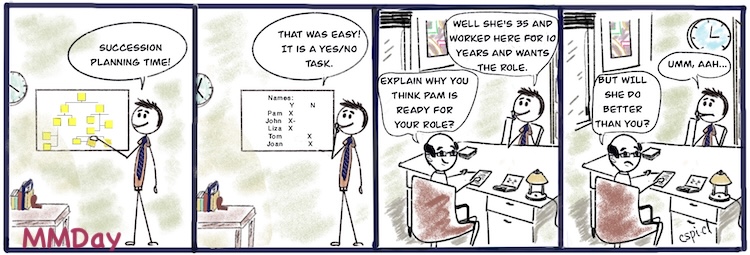
Thought 1: FORWARD LOOKING
Succession planning in a company is a forward looking activity, not one that is triggered by the promotion or departure of an incumbent.
Thought 2: READY
A company’s organization is never static. Incumbents in various roles are subject to an upward, lateral or exit move. When a role becomes vacant or is created the company is wise to know which employee or employees are ready to step in.
Thought 3: MORPHING
Prior to identifying the readiness of incumbents for particular roles, it is essential to know, within the context of the company’s strategy, what competencies and values will be needed going forward. These competencies might be different in nature or intensity to those previously suitable. Likely, values will remain the same. However, culture, being the commonly practised behaviours and attitudes of the company’s employees, might also require change.
Thought 4: PERFORMANCE
Succession planning requires comparative judging of individual’s readiness for the target role. Fairness and logic require that a standard way of comparing must be part of the process. Past performance carries a lot of weight in this judgement. The performance of individuals is seldom exactly comparable. Candidates will have endured different experiences due to the amount of turbulence encountered in their current or previous roles.
Thought 5: SCOPE
Succession planning is led by business unit and functional Heads. It will include direct reports and two downs. Each role in these three levels require identified candidates.
Thought 6: NEEDED INFORMATION
An easy way to think of the task of succession planning is to imagine a binder with a number of tabs containing specific information. The binder will be standardized for content and allow for easy debate when candidates are being discussed at a senior level. I am in favour of a binder consisting of no more than 15 pages. The principle is that conciseness forces deep thinking. Two ideas mingle here: Paraphrased, Einstein’s: ‘If you cannot explain it so that a six year old ‘gets’ it, you do not understand it’ and , attributed to many, paraphrased, ‘I apologize for the length of my letter. If I had more time it will have shorter.’
Facts
The binder will provide all the needed information to allow for a robust dialog focused on the succession plan for the Head’s area of accountability down to level 3. This is important as senior managers meet to discuss the succession plans.
Obviously facts are needed about the area of accountability and its players. Facts will include all relevant information about the Head and the current reality of their area of accountability.
An up-to-date organization chart and history of individual promotions, lateral moves, role creation or change, resignations and current incumbents and time in role, will be included.
The highlights of a 360, when it was done, what changed since then also fits into the ‘facts’ part of the binder. The 360’s relate only to the head and those who have been identified as possible candidates.
Performance
Information regarding the performance of the identified potential successor must be as factual as possible. The results that they have achieved, need to be linked to their actions, decisions and work. If KPI’s or related measures are used these can form a basis for performance.
Performance will also cover their effectiveness in leading, working on teams, collaborating with peers and third parties and living the values of the company. These aspects also need to be based on actual observation or data. Avoid gut feel and bias in highlighting these performance criteria.
At a higher level, and depending on the requirements of the role they are being considered for as a successor, consider their experience in the required capability. For example, in the targeted role and looking to the future of the role, the incumbent might be required to develop effective relationships with regulators. Has the possible successor demonstrated any results in developing effective relationships with 3rd parties who were not suppliers?
Thought Seven: DISCUSSION AND COMPARING
It is important that the number of people comprising peers and more senior people to the Head engage in a discipline discussion looking at all the potential successors. In doing this the binder must be standardized to enable easier comparisons.
If necessary, a number of matrixes can be built using the data in the binder.
Thought 8: DEVELOPMENT PLANS
It is likely that candidate successors will need to develop in one or more areas to be prepared for the role(s). These development plans will fall into one or more of the following:
1. Experience: Giving a accountability for a project or department which will require them to demonstrate capability in a recognized developmental area.
2. Learning: Identified learning needed might be through training, undertaking specific studies, working in a different department or area.
3. Relating/leading: Appoint the candidate to work on a specific team working on a meaningful project to develop their teamwork and networking capabilities.
4. Coaching/mentoring: Provide a mentor or coach to the candidate, with specific objectives for development. Mentoring provides insight and direction with regard to career development. Coaching, typically focussed on personal behaviours and/ or skills.
FINAL THOUGHT
In summary, succession planning is understanding what a role requires in capabilities and performance, and using this knowledge to determine the competencies capabilities and performance history required of a suitable candidate.
On the judgement side us as much factual data as possible. Avoid using gut feel or or judging based on little actual knowledge.
Finally, anticipate that all candidates will require some learning or development work to be fully prepared for the role.
Remember that no President, CEO or Manager experience the roles until they are actually in it!
